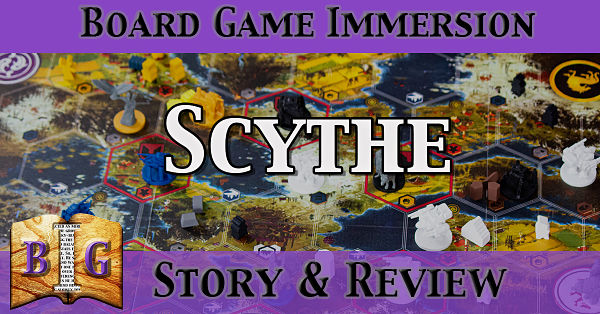At a Glance: Scythe
Designer: Jamey Stegmaier
Publisher: Stonemaier Games
Artists: Jakub Rozalski
Player Count: 1-5
Suggested Age: 14+
Playing Time: 90-115 minutes
Theme: Science fiction, alternate history
Mechanics: Engine building, area control, king of the hill
And nothing ‘gainst time’s scythe can make defence, / Save breed to brave him when he takes thee hence.
– William Shakespeare
Intro Story: The Factory
The snow crunched as Dmitri jumped off his long-tailed goral, the dark snow inadvertently polishing his boots. The sooty snow was remnants of the Great War, a time when gears and oil and soot and grime permeated the world. The Factory was the cause of the mess, producing mechs that stood higher than the tallest building and perhaps as heavily armed as it was armored. Dmitri slung his rifle over his shoulder; he wasn’t expecting trouble, but that never seemed to keep it from coming.
The Factory stood before him, purple roofs a stark contrast to the rusty exterior. The Factory had been the center of production during the war, teaming with life and the sounds of steel on steel, the sounds of progress. Now all that remained were the sultry moaning of the wind as it blew between metal frames, like the voice of those lost during the countless accidents when it was still operating. Like the voices of those mourning their lost jobs following the war.
Dmitri unbuttoned his double-breasted coat, opening it up to feel the brisk air against his bosom. He kept his beaver-skinned hat on his heat; it wouldn’t do to get an ear infection, especially this far from home…and help. Spring was late in coming, but life was beginning to stir.
And more than just the wildlife, he thought, glancing over his shoulder.
The Factory was in unclaimed territory, and rumors were spreading that nearby nations were on the move to be the first to the Factory to claim it for their own. Fortunately, Dmitri had decided to investigate the abandoned region and see what he could scavenge.
A bird screeched above Dmitri. He looked up to see an eagle circling above the factory. He looked around, on the verge of panicking. To the East, a woman came into view riding on a tiger. A man rode a muskox, slowly ambling his way toward the Factory from the north.
The other nations were on the move. Dmitri ran toward the Factory, desperate to find something—anything—before the others arrived. He didn’t have long before they’d be there. If he didn’t get out in time, there would be a firefight as sure as the snow around the Factory was filthy. Dmitri didn’t come to claim the Factory for himself; he just wanted secrets that would help his struggling nation.
He ignited his flashlight as he entered the dark Factory and went to work.
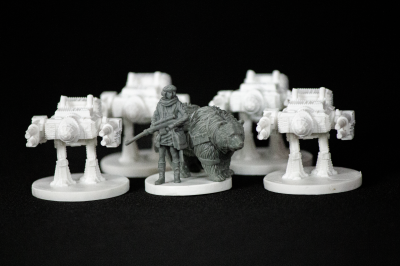
Note: I was provided a complimentary copy of Scythe for the purposes of review. The thoughts and opinions in this review are my own.
Roadmap
This review of Scythe has two parts. First, there is the Short Review, where various aspects of the game are discussed. Then comes the Gameplay Review, in which the setup and gameplay are discussed in detail, along with initial thoughts. Following the Gameplay Review section are some final thoughts and a final verdict of the game. Feel free to jump around, or read it all in one go.
Short Review
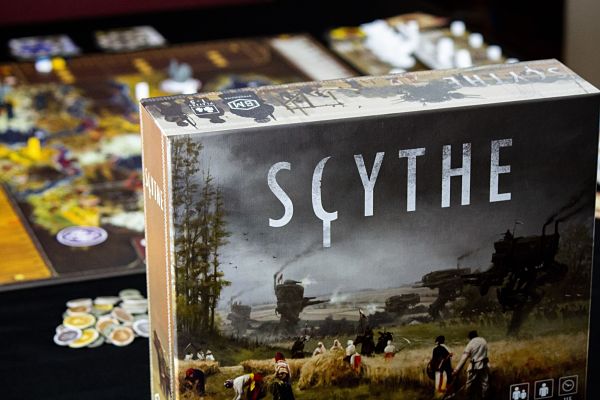
Immersion
During the gameplay review further down, we didn’t talk about the encounters in Scythe, but they play a large role in the deeper immersion of theme and gameplay. Making decisions, whether good or not-so-nice, gives you a sense of what the world is like. It’s a relatively small touch that really adds to the game’s thematic immersion.
Aside from encounters, there are miniatures of mechs and characters (with their animal counterparts) that help the players to visualize what is going down. I don’t care who you are, but when you see an army of mechs heading your way, your sweat glands start dripping.
The story of Scythe is what you make it, and I love that. Of course, you can see it as a game of taking actions, but I like to think that each action means something to my character, to my faction as a whole. Moving to stake claim at the factory, building mechs to defend my territory, and upgrading my war machine to be more productive…it’s all there. It is what you make it, and everything about Scythe—from the board and miniatures to the encounters and actions—plays right along with the theme.
I think it’s safe to say that the immersion factor of Scythe is quite high. While there is no officially progressing story, the players become the storytellers with their actions and table talk. While Scythe may not be narrative-driven, it in no way lacks in immersion.
Theme
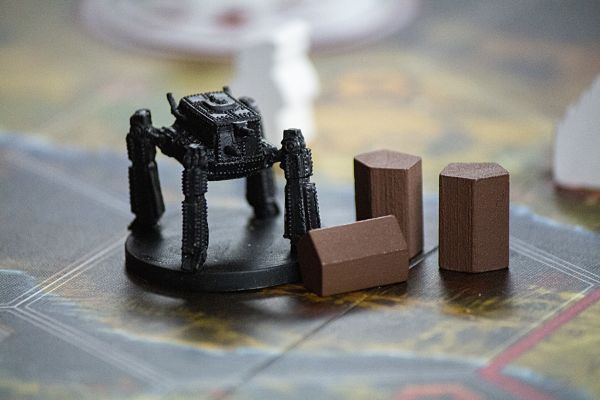
The diesel-punk, alternate history theme isn’t one I would have come up with, but it works. Oh, but it works. The theme comes off strong in the encounters and miniatures. The actions help you play out the theme, and they fit well.
The artwork is gorgeous, and helps provide a sense of scale and realism to everything. While some artists or publishers may have wanted a look that was more cartoony or less realistic, Stonemaier Games opted to go for realistic art, and it pulls you right in to the theme.
Components
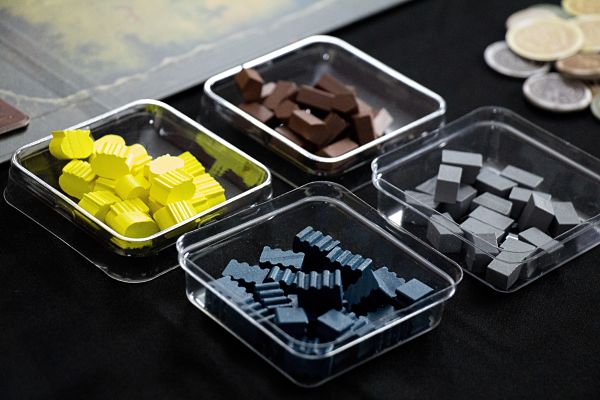
I have nothing but good things to say about the components of Scythe. The miniatures are sturdy (I may have accidentally dropped some while standing up, and they didn’t break when they hit the floor, so that’s a good sign) and the other pieces are nice, solid wood. The resources are are shaped to look like the actual resources, too. The player and faction boards are thick, and the cards certainly feel like quality.
If you’ve ever played a game by Stonemaier Games before, then you’re undoubtedly familiar with their dedication to quality components, and that is just as true for Scythe.
Standout Performances
While I love pretty much everything about Scythe, there are a few things that stand out from the rest:
- Stellar art
- Quality, detailed miniatures
- Balanced at all player counts, including two players
- Easy setup
- Smooth gameplay
- Encounters (varying each game and increasing overall immersion)
Breaking the 4th Wall
I get it, it’s tough to have a 100% immersive board game. Some things will obviously take you out of the narrative. But, I found Scythe to be very good at the immersion factor. However, there were a few things that might be considered as breaking the fourth wall. Or, in other words, this was a weaker aspects of the game.
Solo Automa
While the Automa is wonderfully done, sometimes the way it moves and carries out actions isn’t in accordance to how other players would, or even with the laws of physics. That said, once you get the hang of controlling the Automa, turns are once again smooth. It may take a full game to get comfortable with the Automa rules, but I found it to be well worth it in the end.
Aside from that, I didn’t find anything that took away from the gameplay.
Gameplay Review
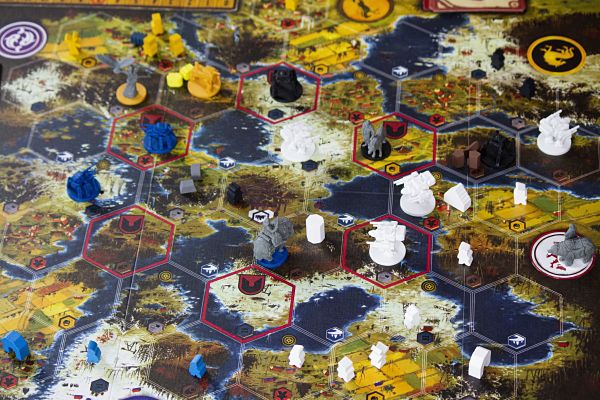
Scythe First Impressions
From the box art alone, Scythe looks amazing. You’ve got farmers doing things the old fashioned way (i.e. with scythes), and then there are these gigantic mechanical beasts and tiny (in comparison) cavalry in the background, apparently waging war on each other as the farmers continue with their harvest.
Whoa.
Needless to say, my first impressions of Scythe were everything from awestruck wonder to “Boy, this is gonna be a great game!” And was I right? Sure was. I know we’re told not to judge a book by its cover, but if a board game’s box art demands me to stop and stare at it, I can usually tell I’m going to like it.
When I opened the box, there was a lot of stuff to greet me. Intimidating? A bit, perhaps. But I love a good “big” game, so miniatures and tiles and wooden bits of various shapes were a good sign—it was a promise kept that the box art had made.
Fortunately, everything fell into place easily enough. And when there’s a big game that doesn’t need a couple of flow charts to make sense of it, I call that a win.
My first impressions were nothing but encouraging, and the gameplay did not disappoint.
Setup
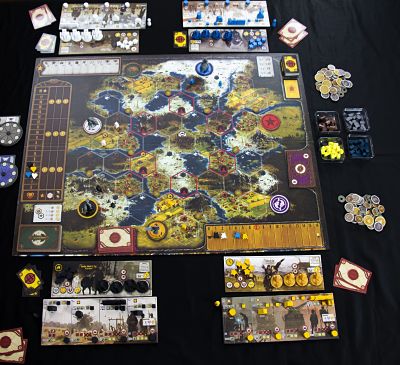
By looking at the box, the components, and the rule book, one would think setup would be crazy-pants difficult. But it’s not! Sure, there’s some setup involved, but for a game this size, that’s expected.
The way I set up the game is to first separate all the cards into their respective decks, shuffle them, and place them where they belong on the board. Players are randomly assigned one faction board and one player mat; these combinations can be mixed around to create a bunch of variations for a single faction, which is quite nice. Give players their leader miniature and four mechs (in their faction’s color), along with all components matching their faction’s color. Then, you essentially fill in the holes in your player and faction boards. (Feel free to refer to the rule book for the minutia because, let’s be real here, the rule book does a great job at it, so there’s no point rehashing it.)
Each player’s faction mat and player mat show you what you start with: power (scarab), combat cards, objective cards, popularity, and coins. Everybody will be getting different amounts of stuff, so pay attention.
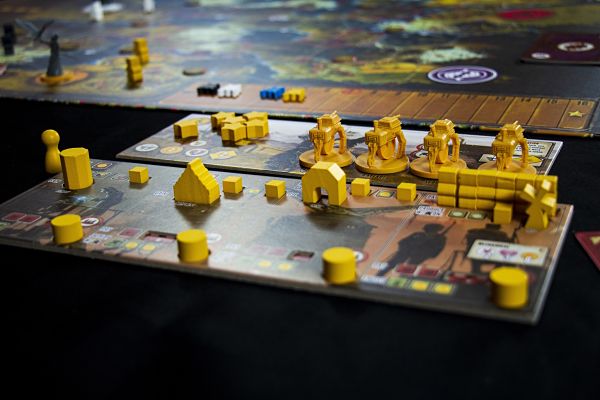
Place your character miniature on your home base (your faction’s symbol) and two workers on the board, one on each space adjacent to your home base. The starting player is the one with the lowest number on the label on their player mat (see below). You’re ready to play!
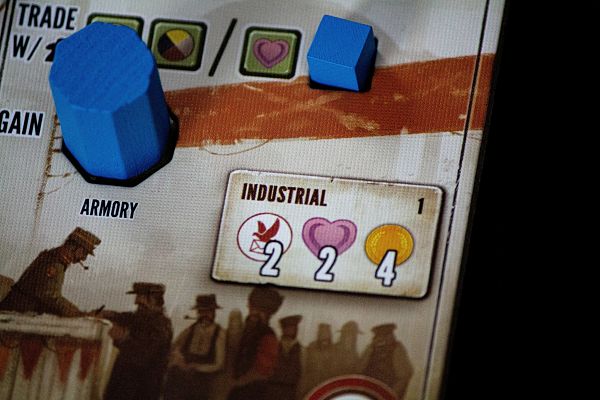
Gameplay
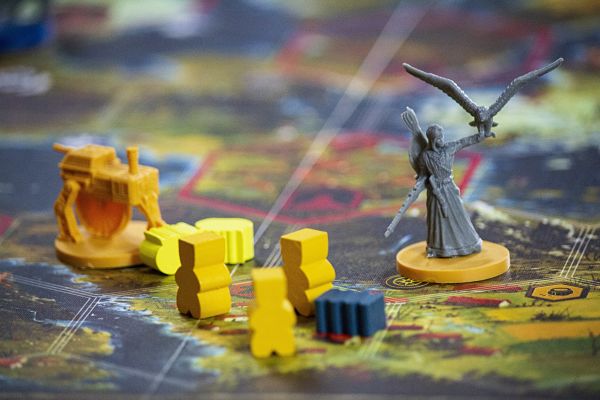
There’s a lot to look at on your player board, but don’t worry; it’s not too difficult to digest. Essentially, on your turn, you will place your action token on one of the action spaces on your player mat. Then you do the top action, paying the cost if applicable.
There are four top-row actions (not necessarily in the same order on each player mat):
- Bolster
- Produce
- Move
- Trade
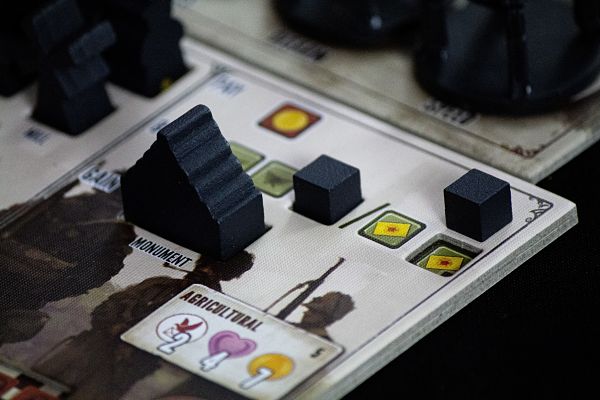
To bolster, pay a coin. Then, increase your scarab token on the power track by two (three if you’ve upgraded) or gain a combat card (two if you’ve upgraded).
To produce, pay what is visible (from underneath the row of workers) and then gain resources on two (three if you’ve upgraded) different hexes/spaces. You can only produce on spaces on which you have workers, so keep that in mind. Resources help you take bottom-row actions (to be discussed in a bit). Workers also produce workers, so that’s neat.
Moving is simply moving a unit (worker, mech, or character) one space per movement icon (the little running man). Instead of moving, you can instead get a coin.
Trading may not look too appealing at times, but it can be a great way to get specific resources when you need them. Of course, you could always opt out of gaining resources and move your heart marker up thee popularity track instead. Both are worthwhile ventures.
Once you’ve taken your top-row action, you may then take the bottom-row action from the same column. The bottom-row actions are:
- Upgrade
- Deploy
- Build
- Enlist
To take a bottom-row action, you must be able to pay the resource cost. When you do, take the action.
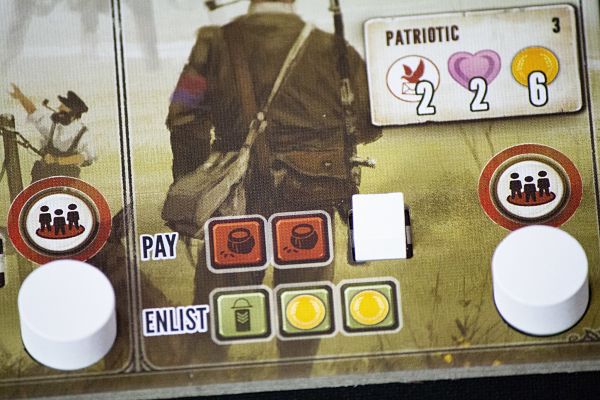
Upgrading lets you move one of thee small cubes from the top row and place it in a slow on the bottom row. This makes your top actions more lucrative, and your bottom actions a little cheaper.
Deploying is simply putting a mech into play. When your mechs move, they can carry your workers for free (hitchhiking is highly encouraged in alternate 1920s Europa). Deploying mechs also unlocks abilities your mechs and character can use, including the ability to cross rivers, which is kind of important if you ever want to leave your starting island. Each faction has different abilities hidden underneath their mechs’ starting place on the faction board, so use those to your advantage!
Building is, well, building a building. You have four buildings (top row), and when you pay for a build action, you can place a building in an area with a worker. Windmills give you a bonus production when producing, the monument and armory grant bonus popularity and power (respectively), and the mine allows travel from any tunnel space to the space where the mine is (and vice versa).
Enlisting helps you get bonuses when the players next to you take certain actions. Pay the cost and then remove one of the four large discs from the bottom row and place it on one of the enlist icons on your faction board—immediately gain that bonus that you covered.
Factory Card Actions
If your character makes it to the factory in the middle of the board, you get to select a factory card to keep. These cards provide additional actions, and the bottom action gives one unit two movement. Getting to the factory first means you have more cards to choose from, and the factory cards make it easy to move units every turn, if you so desire.
Combat
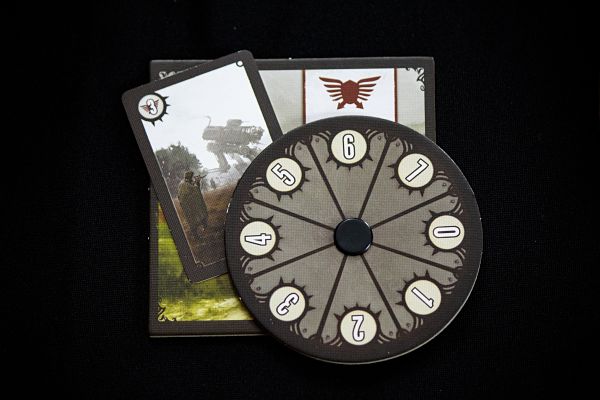
With big ol’ mechs and box art that screams blood and carnage, combat doesn’t play as large a role as you might think. Of course, that depends on who you’re playing with, too.
If you move at least one mech or your character into an area containing another mech or character, combat will happen at the end of your turn. You take one of the combat dials and select how much power you want to spend (up to 7). Of course, you have to have that much power as indicated on the power track in order to use that much. You’re also able to play combat cards—one for each combat unit (i.e. mech or character) participating in the battle.
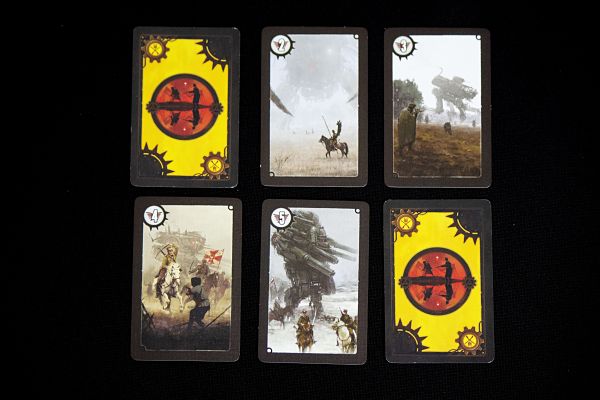
Combat cards give you added power to your attack, so while your opponent knows how much power you have on the power track, you can blow them out of the water with your combat cards. Also, if you win the battle and force a worker to run away to its home base (shame on you), you lose popularity. To avoid that, try only fighting units that don’t share a space with a worker.
Winning
There is a lot to consider on every turn, but if you’re struggling to find a strategy, focus on doing things that will get you victory stars. Stars give you points at the end of the game, the amount varying depending on your popularity. You also get points (again, the amount varies depending on your popularity) for areas controlled and for every two resources. Your coins are also worth points at a 1:1 ratio. Lastly, the structure bonus tile gives points depending on where you’ve built your buildings. Score that and add it to everything else, and if you have the most points, you win!
Thoughts on Gameplay
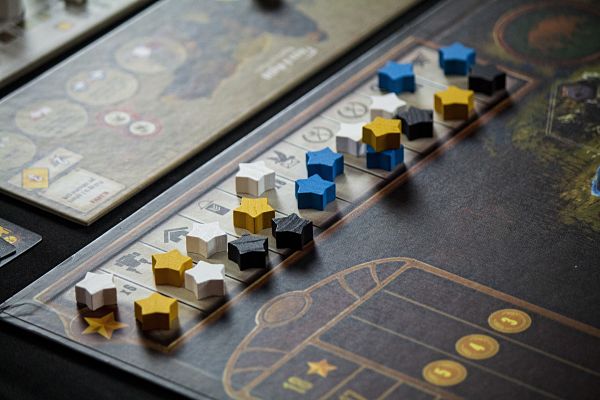
That’s a hefty amount of text! And there’s stuff we didn’t talk about. That said, once you get going with a few turns, things should start falling into place quickly enough. There’s not so much that it gets overwhelming, but there’s still a depth that really makes you think about your choices.
On Board Game Geek, Scythe is rated a 3.40 / 5 as far as complexity goes (which can be considered quite complex). Once you know what your actions do (and there are only four, remember), reacting to your opponents’ actions will come naturally. The complexity rating on Board Game Geek might turn some off from playing Scythe, but if you sit down and learn it with someone who already knows how to play, you should be fine.
I find the playing time of 90-115 minutes (as indicated on Board Game Geek) to be fairly accurate, which isn’t always the case with playing times. While that may seem like a lengthy game for some, I find that the time flies by. That’s the sign of a good game.
I’m also very pleased with the balance in a two-player game. I’ve played everywhere from 1-7 players, and all player counts have been nothing short of wonderful. I was worried that a two-player game would be a game of avoidance (since the map is so large for just two factions), but the tunnels and area around the factory made for some hotly contested games. While I have a regular, weekly game night, I still play a lot of games with just me and my wife, so having a good balance at that player count is priceless.
Solo Play
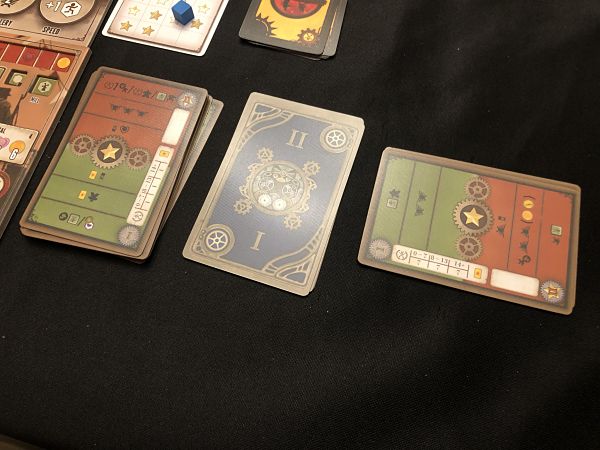
I am always on the lookout for a good solo game—one that captures the feeling of playing multiplayer instead of simply trying to beat a high score (although those can be fun too). Scythe’s Automa (AI) is well greased and plays like a smooth sax during jazz night. I love it. Sure, the Automa units teleport further than a regular player’s units, but the Automa rule book clears up why that is (it’s alternate history science, duh.)
It did take me most of one game to get comfortable with the AI so that I didn’t have to constantly flip through the rule book, but that’s because there’s a lot of actions it’s trying to simulate to make it feel like it’s a real person.
The Automa’s turns are well-scripted, and while the units may teleport places and do some inhuman things (such as spawning units without having to pay for them), it is remarkably balanced. And that makes for a wonderful solo experience.
Final Thoughts on Scythe
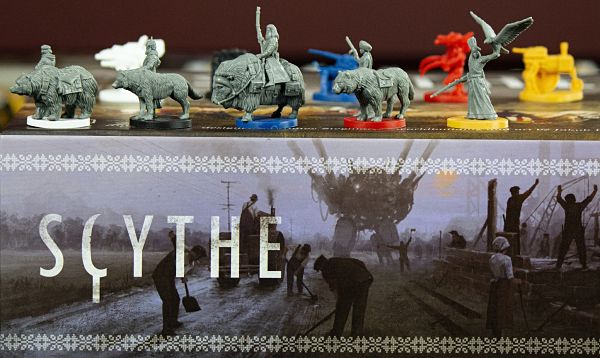
There’s something to be said about a big ol’ board game—with lots of miniatures—that is still relatively easy to understand. Scythe is bulky, yes, but don’t let that intimidate you. Truth be told, I thought I was going to spend my entire first game trying to figure things out. In the end, I won. And the other players were all Scythe veterans. There you have it.
I love Scythe. I think it’s a fantastic game, and it’s the same amount of engaging with seven players as it is with just one. The theme is strong, and while it’s not playing out like a storybook, the immersion factor is still up there. I absolutely love playing games, but if there’s one things I love even more than playing them, it’s weaving my own narrative as I do so.
In the end, there’s a reason Scythe is rated as highly as it is. It’s ranked #11 both for strategy and overall (at least, it is at the time of this writing), and when you get playing it, you’ll understand why.
Final Verdict
Scythe, when all is said and done, is captivating. It never gets old (at least, it doesn’t for me), and I could play it again and again. While standing ovations are reserved as the pinnacle of compliments to performers, Scythe comes close to reaching that supreme stage. In fact, I’m on the verge of standing up to applaud as it is.
The Final Verdict is based on a scale of 1-7, although this scale is not numbered. Instead, it uses thematically appropriate words to describe the performance of the game. Remember, the Final Verdict is based off of my likes and preferences.
Read more reviews—and stories—at Board Game Immersion!
Verdict Scale (Lowest to Highest)
Tomatoes – This game was emotionally taxing and difficult to finish.
Uninspiring – This game had me daydreaming about other games.
Lackluster – This game had its moments, but it probably won’t see much table time.
Laodicean – This game is decent. It works. There’s a reason people like it.
Two Thumbs Up – This game is very good
Captivating – This game is outstanding! It’s more than good; it’s practically a staple.
Standing Ovation – This is the best game you will ever play. Period.

